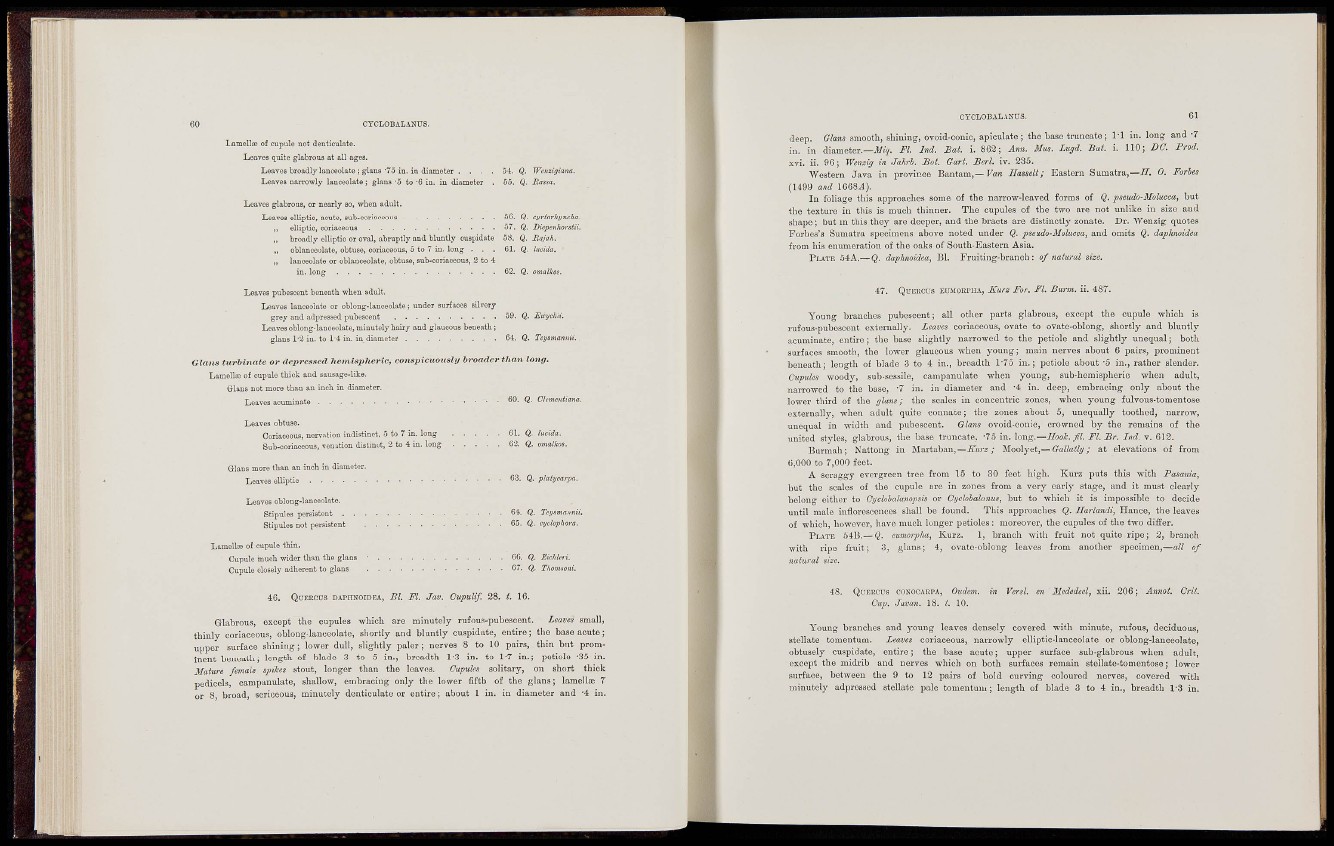
60 CYCLOBALANUS.
Liamellffi of cupule not denticulate.
Leaves quite glabrous at all ages.
Leaves broadly lanceolate; glans-To in. in diameter . . . . 54. Q. Wcnzigiana.
Leaves narrowly lanceolate; glans "5 to "6 in. ic diameter . 55. Q. Rassa.
Leaves glabrous, or nearly ao, when adult.
Leaves elliptic, acute, sub-coriaceous 56. Q, cyrtorhyncha.
„ elliptic, coriaceoiis 57. Q. Diepenhorstii.
„ broadly elliptic or oval, abruptly and bluntly cuspidate 58. Q, Eajah.
„ oblanceulate, obtuse, coriaceous, o to 7 in. long . . . 61. Q. ludda.
„ lanceolate or oblanceolatiJ, obtuse, sub-coriaceous, 2 to 4
in. long 62. <3. omalkos.
Leaves pubescent beneath when adult.
Leaves lanceolate or oblong-lanceolate; under surfaces silvery
grey and adpressed pubescent 59. Q. Eicyckii.
Leaves oblong-lanceolate, minutely hairy and glaucous beneath;
glans 1-2 in. to 1-4 in. in. diameter 64. Q. Tcyamannii.
Glans turbinate or depressed hemispheHc, conspicuously broader than long.
Lamellce of eupule thick and sausage-like.
Glans not more than an inch in diameter.
Leaves acuminate Q' Chmentiana.
Leaves obtuse.
Coriaceous, nervation indistinct, 5 to 7 in, long Gl. Q. laeida.
Sub-coriaceous, vcuition distinct, 2 to 4 in. long 62. Q. omatkos.
Glans more than an inch in diameter.
Leaves elliptic Q. plalycavpa.
Leaves oblong-lanoeolate.
Stipules persistent 64. <3- Tcymannii.
Stipules not persistent 65. Q. cyclophwa.
Lamell® of cupule thin.
Oupule inuch wider than the glans • 6G. Q. Eichleri.
Cupule closely adherent to glans 67. Q. Thonmni.
46. QUEECUS DAPHNOIDEA, Bl. M. Jav. CupuUf. 28. t. 16.
Glabrous, except the cupules which are minutely rufous-puhescent. Leaves small,
t h i n l y coriaceous, oblong-lanceolate, shortly and bluntly cuspidate, entire; the base acute;
upper surface shining; lower dull, slightly paler; nervea 8 to 10 pairs, thin but prominent
beneath; length of blade 3 to 5 in., breadth 1-3 in. to 1-7 in.; petiole -35 in.
Mature female spikes stout, longer than the leaves. Cupulea solitary, on short thick
pedicels, campanulate, shallow, embracing only the lower fifth of the glans; lamellae 7
or 8, broadj sericeous, minutely denticulate or entire; about 1 in. in diameter and -4 in.
CTCLOBAL-VNUS. 61
deep. Glans smooth, shining, ovoid-conic, apiculato; the base truncate; M in. long and -7
in. in diameter.—il/ii. Fl. Ind. Bat. i. 862; Ann. Mus. Lugd, Bat i. 110; DO. Prod.
xvi. ii. 96; Wenzig in Jakrb. Bot. Gart. Bcrl. iv. 235.
Western Java in province Bantam,—Fare Jlasselt; Eastern Sumatra,—//. 0. Forhes
{1499 and 1668J).
I n foliage this approaches some of the narrow-leaved forms of Q. pseudo-Molucca, but
the texture in this is much thinner. The cupules of the two are not unlike in size and
shape; but in this they are deeper, and the bracts are distinctly zonate. Dr. "Wenzig quotes
Forbes's Sumatra specimens above noted under Q. pseudo-Molucca, and omits Q. daphnoidea
from his enumeration of the oaks of South-Eastern Asia.
PLATE 54A.—Q. daphnoidGa, Bl. Fruiting-branch : of natural size.
47. QuiiKCUS EUMORPIIA, Kurs For. Fl. Burm. ii. 487.
Young branches pubescent; all other parts glabrous, except the cupule which is
rufous-pubescent externally. Leaves coriaceous, ovate to ovate-oblong, shortly and bluntly
acuminate, cntii-e; the base slightly narrowed to the petiole and slightly unequal; both
surfaces smooth, the lower glaucous when young; main nerves about 6 pairs, prominent
beneath; length of blade 3 to 4 in., breadth 1-75 in.; petiole about -5 in., rather slender.
Cupulas woody, sub-sessile, campanulate when young, sub-hemispheric when adult,
narrowed to the base, -7 in. in diameter and -4 in. deep, embracing only about the
lower third of the glans; the scales in concentric zones, when young fulvous-tomentose
externally, when adulfc quite connate; the zones about 5, unequally toothed, narrow,
imequal in width and pubescent. Glans ovoid-conic, crowned by the remains of the
united styles, glabrous, the base truncate, '75 in. long.—Hook. fil. Fl. Br. Ind. v. 612.
Burniah; Nattong in Martaban,—K u r z ; Sloolyet,— Gallatly; at elevations of from
6,000 to 7,000 feet.
A scraggy evergreen tree from 15 to 30 feet high. Kurz puts this with Pasania,
but the scales of the cupule sre in zones from a very eariy stage, and it must clearly
belong either to Cyclohalanopsis or Cyclohalunus, but to which it is impossible to decide
until male inflorescences shall be found. This approaches Q. Harlandi, Hance, the leaves
of whicii, however, have much longer petioles: moreover, the cupules of the two differ.
PLATE 54B.— Q. eumorpha, Kurz. 1, branch with fruit rot quite ripe; 2, branch
with ripe fruit; 3, glans; 4, ovate-oblong leaves from another specimen,—all of
natural size.
48. QUERCUS COSOCAKPA, Oudcm. in Versl.
Cup. Javan. 18. t. 10.
Mededeel, xii. 206; Annot. Crit.
Young branches and young leaves densely covered with minute, rufous, deciduous,
stellate tomentum. Leaves coriaceous, narrowly elliptic-lanceolate or oblong-lanceolate,
obtusely cuspidate, entire; the base acute; upper sui-face sub-glabrous when adult,
except the midrib and nerves which on both surfaces remain steilate-tomentose; lower
surface, between the 9 to 12 pairs of bold curving coloured nerves, covered with
minutely adpressed stellate pale tomentum; length of blade 3 to 4 in., breadth 1'3 in.